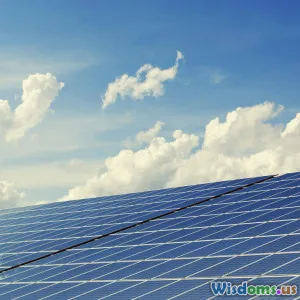
Analyzing the 2025 Renewable Energy Policy Roadmaps Worldwide
9 min read Comprehensive analysis of 2025 worldwide renewable energy policy roadmaps shaping the future of clean energy growth and climate goals. (0 Reviews)
Analyzing the 2025 Renewable Energy Policy Roadmaps Worldwide
Renewable energy has rapidly transformed from a niche environmental concern to a strategic global imperative. As the world races against the clock on climate change, the policies crafted today profoundly influence the accessibility, efficiency, and scale of clean energy generation tomorrow. The year 2025 marks a critical juncture: ambitious targets are set, investments surge, and innovative regulations aim to synchronize economic growth with environmental sustainability. This article meticulously analyzes the 2025 renewable energy policy roadmaps worldwide, unraveling how diverse strategies converge to forge a low-carbon future.
Introduction: The Imperative of 2025 Roadmaps
The year 2025 stands as a symbolic and practical milestone for renewable energy adoption. Several countries and international bodies have defined specific targets—such as achieving net-zero emissions, expanding solar and wind capacities, and developing green hydrogen ecosystems—all aimed at decarbonizing economies and boosting energy security. Beyond fixed goals, 2025 policies represent the embodiment of lessons learned from technological, economic, and social dimensions of clean energy deployment.
Why does 2025 matter?
- Midterm marker toward the 2030 and 2050 climate commitments set by the Paris Agreement.
- Alignment of emerging renewable energy technologies, like next-gen solar panels and offshore wind, with regulation.
- Increased global collaboration amid geopolitical complexities influencing energy markets.
Thus, understanding these policy frameworks is essential for stakeholders ranging from governments and investors to technologists and communities.
Global Trends Shaping 2025 Renewable Energy Policies
1. Transition from Fossil Fuels to Renewables
Many countries acknowledge the urgent need to phase out fossil fuel dependency. For example, the European Union’s 'Fit for 55' package targets a 55% reduction in greenhouse gases by 2030, incorporating renewable energy directives that set ambitious capacity expansion plans for wind and solar. Similarly, nations like Canada and Japan have designed policies to reduce coal-fired power plants and incentivize renewables via subsidies and tax credits.
2. Integration of Green Hydrogen
Green hydrogen is heralded as a pivotal component in decarbonizing sectors that are hard to electrify, such as heavy industry and transportation.
- Germany’s National Hydrogen Strategy allocates €9 billion toward creating a hydrogen economy by 2025, focusing on electrolyzer technology and import partnerships.
- Australia, endowed with vast solar resources, positions itself as a future green hydrogen exporter with a target to produce substantial hydrogen volumes by 2025.
3. Renewable Energy in Developing Countries
Policies in developing nations emphasize increasing access to clean energy to advance socio-economic development while mitigating climate risks.
- India’s renewable energy roadmap envisions 500 GW of non-fossil fuel-based power capacity by 2030, with significant developments already underway as it approaches the 2025 midpoint.
- In Sub-Saharan Africa, initiatives like the Africa Renewable Energy Initiative coordinate region-wide policies supporting decentralized solar mini-grids.
4. Digitalization and Smart Grids
To optimize renewable integration, 2025 policies embed digital technologies for grid flexibility and demand-side management.
- The United States Department of Energy’s Grid Modernization Initiative funds smart grid research to accommodate variable renewable inputs.
- Countries like South Korea have incorporated smart meters and AI-assisted grid management to enhance efficiency.
Case Studies of Leading 2025 Policy Roadmaps
European Union: A Unified Approach to Green Transition
The EU stands out for harmonizing its member states' efforts under a cohesive framework. Its Renewable Energy Directive (RED II) and subsequent policy updates require member countries to commit to binding renewable energy shares—increasing overall share to at least 32% by 2030, with interim targets by 2025.
- Investments: Multi-billion-euro funding mechanisms like the European Green Deal Investment Plan guarantee capital for infrastructure and innovation.
- Legislation: Carbon pricing and emission trading systems enforce accountability.
- Outcomes: The EU expects to add approximately 40 GW of offshore wind power by 2025, revolutionizing its energy mix.
China: Scaling Renewables at an Unprecedented Pace
China’s 14th Five-Year Plan (2021-2025) accelerates renewable energy growth toward peaking carbon emissions before 2030.
- Planned capacity includes reaching around 1,200 GW of wind and solar power combined by 2025.
- Policies include streamlined permitting for renewable projects and a focus on domestic innovation in solar tech.
- China is also emerging as a dominant player in battery storage policy development, vital for renewable energy stability.
United States: Market-Driven and Federal-State Coordination
Post-2020 policies combine aggressive federal incentives with state-level renewable portfolio standards.
- The Inflation Reduction Act of 2022 restored and enhanced tax credits for solar, wind, and other clean technologies, influencing massive deployment projections for 2025.
- States such as California, New York, and Texas pursue ambitious goals—California targets 60% renewable electricity by 2030, with significant strides expected by 2025.
Challenges and Opportunities ahead of 2025
Regulatory and Financial Barriers
While policy frameworks have solidified, implementation hurdles persist.
- Permitting delays: Infrastructure projects face bureaucratic challenges, threatening timelines.
- Grid limitations: Many grids are not sufficiently modernized to handle large intermittent capacity.
- Investment gaps: Emerging markets often struggle with financing renewable ventures.
However, the rapid evolution of green bonds, international climate finance, and private sector engagement continues to narrow these barriers.
Technology Innovation and Deployment
By 2025, key technologies improving renewables integration will reach maturation phases:
- Advanced battery storage, including solid-state designs, aims to reduce costs dramatically.
- Floating offshore wind turbines open vast ocean spaces for power generation.
- Artificial intelligence in energy management enhances demand-response systems and predictive maintenance.
Social Equity and Community Impact
Renewable roadmaps increasingly recognize the importance of equitable energy transitions:
- Community solar programs and distributed energy resources democratize access.
- Policies aim to create green jobs in vulnerable regions suffering from fossil fuel economic declines.
Conclusion: Toward a Sustainable and Resilient Energy Future
The 2025 renewable energy policy roadmaps worldwide illustrate a complex but hopeful trajectory. By blending ambitious targets, innovative financing, and technological advances, many regions are on a course to redefine energy landscapes profoundly. Despite obstacles related to infrastructure, governance, and social equity, the global momentum toward renewables is unmistakable.
For policymakers, investors, and communities, the message is clear: cooperating to align conditions for renewable energy growth is not optional but essential to meet climate goals and ensure energy security. The coming years to 2025 will be pivotal, not just in adding gigawatts of clean power, but in reinforcing the shared commitment to a livable planet.
References
- European Commission, "Renewable Energy Directive II," 2023.
- International Renewable Energy Agency (IRENA), 2024 Global Renewables Outlook.
- U.S. Department of Energy, "Grid Modernization Initiative," 2023 Report.
- China National Energy Administration, 14th Five-Year Plan Summary, 2021.
- Germany Federal Ministry for Economic Affairs and Climate Action, Hydrogen Strategy, 2023.
This article aims to empower stakeholders with concrete knowledge and spark informed discussions leading to effective action in the vital realm of renewable energy.
Rate the Post
User Reviews
Popular Posts

















